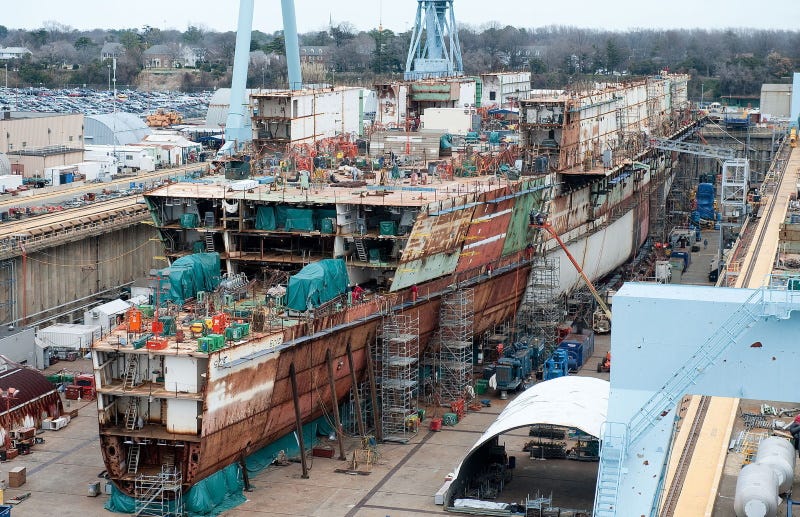U.S. Navy buildup comes with a ‘bloodletting’
Pentagon splurges on warships to match China as economy takes a hit
Enjoy this special edition of Contention — you can read it in under five minutes. If you like it, please take a moment to share it with folks who will probably like it too!
Nine months after the beginning of the worst economic crisis in U.S. history, Congress may finally be approaching an agreement to send American families $600 checks. Twelve million of those families are behind on their rents by an average of $5,850.
But there may be one way those families could get more -- become a naval battleship.
This is because the White House wants to dramatically expand the size of the U.S. Navy to around 500 ships by 2045, up from 297 warships. Altogether, military fiscal plans (.pdf) propose a $759 billion budget for 2022 to ensure "maritime supremacy" over China in the Pacific -- i.e. roughly 10 times the money needed to cancel this year’s back due rents.
Big business, of course, stands to profit handsomely. General Dynamics, Huntington Ingalls Industries and Italian shipbuilder Fincantieri will win huge new contracts to build a new class of aircraft carriers -- not yet defined -- plus new frigates, submarines and a fleet of 150-200 unmanned vessels that could include a class of 2,000-ton drone missile ships.
Additional funds will help stretch the lifespan of existing ships past their expiration dates and expand shipyard infrastructure.
This would represent a massive surge in shipbuilding, going beyond the $740 billion military budget for 2021 which the U.S. Senate approved with a large bipartisan majority on Dec. 11. By 2026, the shipbuilding budget would rise from $27 billion to $39 billion per year, with 355 ships in service by 2031.
But in light of the COVID pandemic, surging poverty, and growing frustration with the lack of new relief from Congress, the politics of naval expansion only work if the sailing branch can cannibalize resources from other parts of the Pentagon. Economists believe that the U.S. GDP will contract 3.6% this year. This, plus rising demands for austerity likely means that federal budgets will stay flat or decrease.
Who will pay for this expansion? The U.S. Army, which would lose thousands of active-duty, reserve and National Guard troops along with cutbacks to future equipment purchases over the decade. “It’s going to be ruthless, there’s going to be a lot of bloodletting and a lot of stuff left on the floor,” U.S. Army Gen. Mark Milley, the chairman of the Joint Chiefs, said this month. “We’re gonna have to do that in the coming years -- no question about it.”
Hearing an Army general advocate for “bloodletting” of his branch to fund a historic rival is somewhat shocking, until you remember the motivation for such a dramatic shift in resources: a future war with China. The People’s Republic now has the world’s largest navy with some 350 warships -- a number which could expand to more than 430 ships by 2030, representing a shift in the “strategic balance” of power at sea, according to the U.S. Naval War College Review (.pdf). This new military power is a reflection of long-term economic trends powering China’s growth.
This growth is slowing, but it’s not stopping. China should record a 2.3% increase in GDP in 2020, an outlier in a world wracked by the pandemic, while powering one-third of global growth in 2021. In terms of nominal GDP -- in market-exchange terms -- China may become wealthier than the U.S. over the next two decades, and on a purchasing-power basis, it already is.
Adding to U.S. urgency: its Navy’s surface fleet is aging fast, and older ships are harder and more costly to maintain. This year, the Navy’s so-called INSURV report (.pdf) -- which tracks the overall health of warships -- found a marked deterioration in the surface fleet’s material condition over the past two years. Engines which power the ships have degraded, as have electrical systems and AEGIS, the suite of sensors and software that help warships defend from air attack.
Despite this growing crisis in readiness, the United States stepped up aggressive maneuvers in the Pacific near China’s waters -- with carrier group operations up 40 percent this year.
There is a Catch-22 here. The Pentagon wants to match China at sea, but is wearing its ships out trying to do it. This then undermines that very effort to match China. The result is to spend more money during a period of economic contraction and widespread unemployment, and even that may not be enough to beat China’s ascent.
What we do know now: families will go hungry, face eviction, and struggle to get by while warmaking earns huge new dividends. Stay tuned with Contention as we track how bad this “bloodletting” will be.
Our only investment advice: This business will get out of control and we’ll be lucky to live through it.
Contact us with any feedback, questions, or stories you think we should cover.
Photo Credit: U.S. Navy





